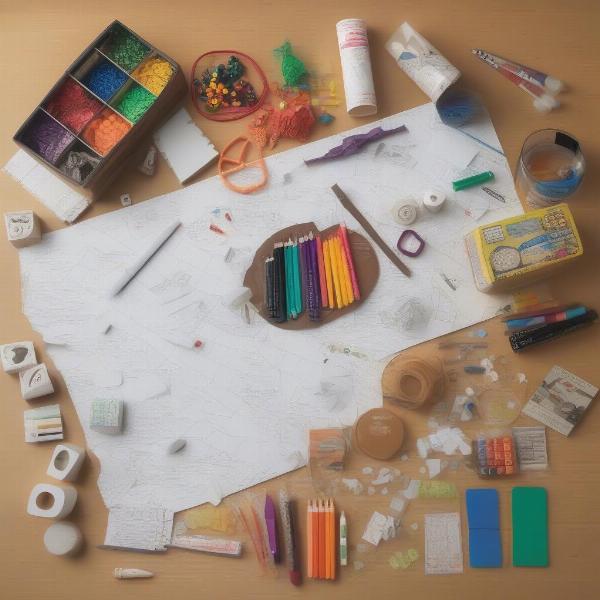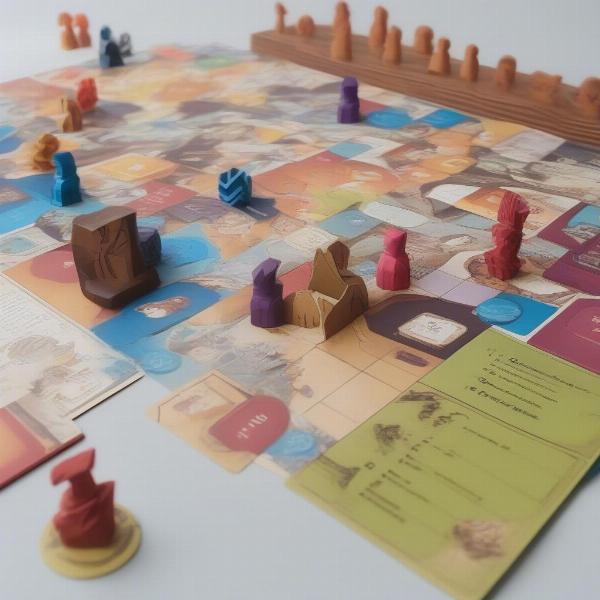Creating your own board games with paper is a fun, affordable, and surprisingly easy way to unleash your creativity. Whether you’re looking for a rainy day activity, a personalized gift, or a way to bring your game ideas to life, paper offers a versatile medium for crafting unique and engaging board games. From simple dice games to complex strategy games, the possibilities are only limited by your imagination.
Designing Your Paper Board Game
The first step in making a paper board game is designing the core mechanics and theme. What kind of game do you want to create? A simple roll-and-move game? A strategic card game? A complex war game? Consider your target audience and the level of complexity you’re aiming for. Once you have a general idea, start sketching out the game board on a piece of paper. Think about the layout, the different spaces, and how players will move around the board.
Choosing a Theme
Picking a theme can make your game more engaging and immersive. Think about themes you enjoy, like fantasy, sci-fi, history, or even something based on your favorite book or movie. A well-chosen theme can inform the game mechanics, art style, and overall player experience. For example, a pirate-themed game could involve collecting treasure, battling other ships, and navigating treacherous waters.
Creating the Game Board
Your game board can be as simple or as complex as you like. You can draw it freehand, use graph paper for precision, or even print out a template from online. Consider using different colors and shapes to make the board visually appealing. Don’t forget to label different areas and clearly mark the starting and ending points.
 Paper Board Game Design and Layout
Paper Board Game Design and Layout
Developing the Rules
Clearly defined rules are essential for any board game. Write down the rules in a clear and concise manner, including how to set up the game, how players take turns, how to win, and any special conditions or rules. Test your rules thoroughly to make sure they are easy to understand and don’t create any loopholes or unfair advantages.
Gathering Your Materials
Once you have your design and rules in place, it’s time to gather your materials. Fortunately, making a board game with paper requires minimal supplies. You will need paper or cardstock for the game board, game pieces, and any cards. Markers, colored pencils, or crayons can be used for adding color and details. Other useful materials include scissors, glue, a ruler, and dice or a spinner.
Choosing the Right Paper
The type of paper you use can significantly impact the durability and feel of your game. Regular printer paper is fine for prototyping, but for a more durable game, consider using cardstock or thicker paper. You can also laminate your game board and pieces for added protection.
 Essential Materials and Tools for Creating Paper Board Games
Essential Materials and Tools for Creating Paper Board Games
Making Game Pieces
Game pieces can be as simple as small pieces of paper or as elaborate as miniature figurines. You can draw your own game pieces, cut out shapes from magazines, or use small toys or objects you have around the house. Get creative and think about how your game pieces can reflect the theme of your game.
Bringing Your Game to Life
With your materials gathered, it’s time to assemble your game. Carefully cut out the game board and any other game components. Glue the pieces together if necessary and add any final touches or decorations. Make sure everything is securely attached and that the game board is sturdy enough to withstand regular use.
Testing and Refining
Before you introduce your game to others, test it out yourself. Play through a few rounds to identify any potential problems with the rules or game mechanics. This is also a good opportunity to fine-tune the game balance and make sure it’s fun and engaging.
“Playtesting is crucial,” says renowned game designer Amelia Hernandez. “It’s the only way to truly understand how your game works and identify any areas that need improvement. Don’t be afraid to make changes based on feedback from playtesters.”
 Example of a Finished Paper Board Game
Example of a Finished Paper Board Game
Other Ways to Make Paper Board Games
Beyond the traditional board game format, there are other creative ways to use paper for game creation. Consider making a card game, a dice game, or even a foldable origami game. The versatility of paper allows for a wide range of game formats and mechanics.
Conclusion
Making board games with paper offers a fulfilling creative outlet and a chance to design personalized games tailored to your interests. From simple dice rolling games to intricate strategy games, How To Make Board Games With Paper is only limited by your imagination. So gather your materials, let your creativity flow, and enjoy the process of bringing your unique game to life.
FAQ
- What kind of paper is best for making a board game? Cardstock or thicker paper is recommended for durability.
- Can I use printed images for my game board? Absolutely! Printing images can add a professional touch to your game.
- Where can I find game piece ideas? You can draw your own, cut out shapes from magazines, or use small toys or objects.
- How do I test my game? Play through the game yourself and with others to identify any issues and refine the rules.
- What if my game is too complex? Start with simpler mechanics and gradually add complexity as needed.
- Can I create a digital version of my paper game? Yes, you can scan your game components and create a digital version using graphic design software.
- Where can I share my finished board game? Share it with friends and family, or even consider posting it online in gaming communities.

